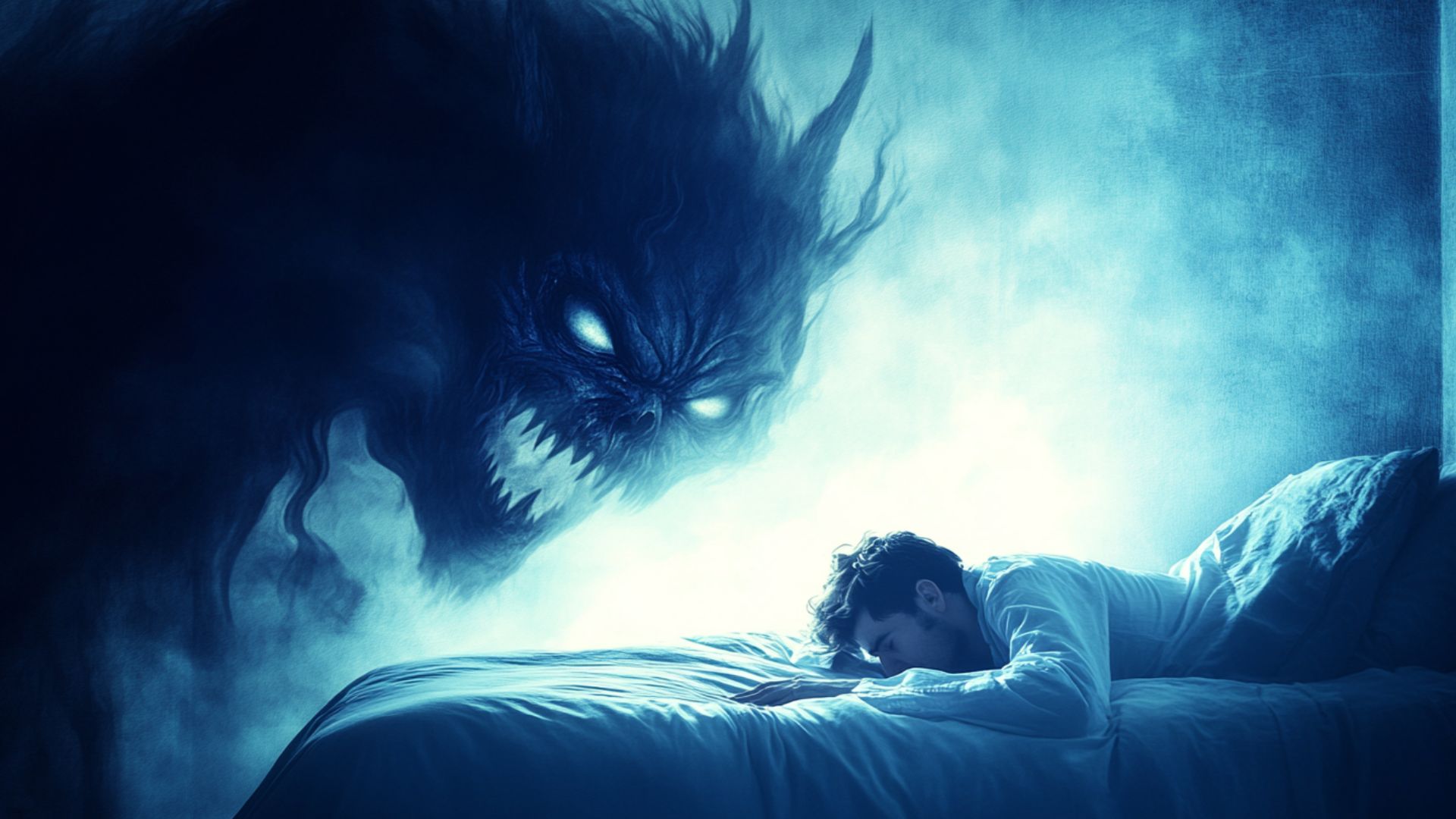“Old hag” syndrome involves a brief inability to move or speak when falling asleep or upon waking. It can be deeply unsettling. People might sense a strange presence, hear unusual sounds, or feel pressure on their chest. Episodes typically last from seconds to a few minutes and occur during transitions between sleep and wakefulness.
Sleep paralysis brain activity happens most often during REM (rapid eye movement) sleep, when brain activity is high but muscles are temporarily paralyzed to prevent acting out dreams. During sleep paralysis, consciousness returns while the body remains paralyzed.
Sleep paralysis involves increased activity in the amygdala, which is linked to fear, and impaired function in the prefrontal cortex, which controls rational thinking. The brain’s sensory areas may misfire, causing hallucinations. Stress, sleep deprivation, and irregular sleep schedules increase the risk of episodes. Though harmless, sleep paralysis can feel deeply unsettling. Understanding its neurological basis helps explain the experience. Research continues to explore why some people experience these episodes more frequently.
What Happens In The Brain During Sleep Paralysis
Sleep paralysis occurs when brain activity during REM sleep overlaps with wakefulness. During REM sleep, the brain is active, but the body is paralyzed to prevent acting out dreams. In sleep paralysis, the mind awakens while muscle paralysis continues due to disrupted brainstem signals.
The amygdala, responsible for fear responses, becomes overactive and causes intense panic. The prefrontal cortex, which controls rational thinking, becomes less active, making it difficult to dismiss hallucinations. Errors in the sensory cortex produce vivid and often terrifying visual or auditory experiences. These neurological disruptions create the unsettling sensation of being “trapped” in one’s body.
Let’s explore the neurological causes of sleep paralysis:
- REM sleep: Continues into wakefulness
- Brainstem: Fails to restore muscle control
- Amygdala: Becomes overactive, triggering fear
- Prefrontal cortex: Functions poorly, reducing rational thinking
- Sensory areas: Misfire, causing hallucinations
- Stress: Disrupts sleep regulation
- Sleep deprivation: Alters brain signaling
- Irregular patterns: Confuse brain transitions
Stress, sleep deprivation, and irregular sleep schedules disrupt normal sleep cycles, increasing the likelihood of these disruptions. Though harmless, the experience can feel deeply distressing. Understanding sleep paralysis brain activity helps reduce fear by explaining its biological basis. Research suggests some individuals may have genetic factors or neurological sensitivities that make episodes more frequent.
Brain Waves And Sleep Disruption
Brain waves and paralysis create a unique neurological pattern that explains the frightening nature of sleep paralysis episodes. During these events, your brain becomes caught between sleep and wakefulness, producing mixed brain wave activity that creates confusion and fear.
Normally, REM sleep features theta waves that support dreaming while muscles remain naturally paralyzed. However, during sleep paralysis, this system malfunctions. The brainstem fails to deactivate muscle paralysis even as consciousness returns, trapping you in an aware but immobilized state.
Key brain wave changes during episodes include:
- Theta waves (4-8 Hz) continue from REM sleep, maintaining dream-like states
- Alpha waves (8-12 Hz) increase, reflecting partial wakefulness and awareness
- Beta waves (12-30 Hz) spike when fear and panic responses activate
- Gamma waves (30-100 Hz) may surge during vivid hallucinations
These disrupted brain waves and paralysis patterns explain why episodes feel so real and terrifying, while stress and poor sleep habits can make them more frequent.
Common Neurological Triggers And Causes
The neurological causes of sleep paralysis stem from disruptions in brain function during sleep transitions. Sleep paralysis often occurs when REM sleep overlaps with wakefulness, causing muscle paralysis to persist. This happens due to brainstem dysfunction, which fails to restore normal muscle control.
Medical conditions like narcolepsy, which disrupts sleep regulation, increase the risk of episodes. Migraines and epilepsy may also trigger episodes by altering brain activity. Psychological factors play a significant role in sleep paralysis as well. High stress or anxiety can disrupt sleep cycles, making episodes more likely. Post-traumatic stress disorder (PTSD) is often linked to sleep paralysis because trauma affects amygdala function and heightens fear responses.
Depression and bipolar disorder may contribute by destabilizing sleep patterns. Sleep deprivation, often from insomnia or irregular schedules, confuses brain signaling and increases vulnerability. Certain medications, like antidepressants, can alter REM sleep and trigger episodes. Genetic factors may make some individuals more prone to these conditions.
The neurological causes of sleep paralysis are complex, blending medical and psychological factors. Maintaining consistent sleep hygiene and managing stress can reduce risks. Ongoing research aims to better understand these triggers.
Sleep Paralysis Symptoms And Risk Factors
Sleep paralysis involves a temporary inability to move or speak during sleep transitions and often feels frightening. Sleep paralysis symptoms include feeling awake but completely paralyzed. People experience sensing a presence, hearing noises, or seeing hallucinations. Some feel chest pressure or difficulty breathing. Episodes typically last seconds to minutes and occur when falling asleep (hypnagogic) or waking up (hypnopompic). Frequency varies – some people experience it once, while others have regular episodes.
Several risk factors increase vulnerability to sleep paralysis. Irregular sleep schedules disrupt brain transitions and raise the chances of episodes. Sleep paralysis symptoms are common in students or shift workers. Sleep deprivation is a significant trigger that disturbs sleep regulation and amplifies risk. Mental health conditions like depression, PTSD, or bipolar disorder are often linked to episodes. Narcolepsy, a sleep disorder, frequently occurs alongside sleep paralysis.
Certain medications, like antidepressants, may alter REM sleep and increase the likelihood of episodes. Sleeping on your back may heighten risk because it affects breathing patterns. Genetic factors play a role, and family history can make individuals more susceptible. Substance use, like alcohol or drugs, can disrupt sleep cycles and make episodes more likely.
Sleep paralysis is harmless but distressing. Consistent sleep routines reduce risk, and avoiding stress while maintaining good sleep hygiene helps prevent episodes. Seeking medical advice for underlying conditions can lower the frequency of symptoms. Research continues to explore why some people are more prone to these experiences.
Managing And Preventing Sleep Paralysis
Managing and preventing sleep paralysis can improve overall health and reduce how often episodes occur. Brain wave disruptions happen during REM sleep transitions, but lifestyle changes can lower risks. Maintain a consistent sleep schedule to regulate brain transitions by going to bed and waking up at the same time daily. Avoid sleep deprivation by aiming for 7-9 hours of sleep nightly.
Reduce stress through relaxation techniques like meditation or deep breathing exercises. Limit caffeine and alcohol, as they disrupt sleep cycles. Avoid heavy meals before bed to prevent discomfort that might affect sleep quality. Exercise regularly, but not close to bedtime, to promote restful sleep. Create a calming bedroom environment with dim lights and minimal noise. Avoid sleeping on your back during neurology of sleep disruption, as this position may trigger episodes.
If episodes persist, consult a doctor to rule out underlying conditions like narcolepsy or anxiety disorders. Cognitive behavioral therapy (CBT) can help manage stress-related triggers. Keep a sleep diary to identify patterns and potential causes of your episodes.
Here are key strategies to reduce sleep paralysis:
- Consistency: Stick to a regular sleep schedule
- Adequate rest: Get 7-9 hours of sleep nightly
- Relaxation: Practice meditation or deep breathing
- Diet: Avoid caffeine, alcohol, and heavy meals before bed
- Exercise: Stay active regularly, but not near bedtime
- Environment: Create a calm, dark, quiet bedroom
- Sleep position: Sleep on your side or stomach
- Medical care: Consult a doctor for persistent episodes
- Therapy: Try CBT for stress management
- Tracking: Keep a sleep diary to identify patterns
Neurology of sleep disruption involves disrupted REM transitions where the brainstem fails to restore muscle control and the amygdala triggers fear responses. However, this condition is manageable with targeted strategies. Adopting consistent sleep schedules helps stabilize brain transitions, while getting adequate sleep prevents deprivation-induced episodes. Stress reduction through meditation or deep breathing calms fear responses.
Avoiding caffeine, alcohol, and heavy meals supports stable sleep cycles. Regular exercise, a calming bedroom environment, and side-sleeping reduce risks significantly. Cognitive behavioral therapy addresses psychological triggers effectively. Keeping a sleep diary helps identify personal patterns. These strategies promote better sleep hygiene and reduce episode frequency. Ongoing research supports their effectiveness in preventing sleep paralysis, offering hope for those affected.
When To Seek Neurological Help
Sleep paralysis and brain activity can be unsettling, but most episodes are harmless. However, persistent or severe cases may indicate underlying issues with brain activity during sleep. Seek neurological help if episodes occur frequently, such as multiple times weekly. Consult a doctor if paralysis lasts longer than a few minutes or causes significant distress.
When to seek neurological help:
- Frequency: Episodes occur multiple times weekly
- Duration: Paralysis lasts beyond a few minutes
- Distress: Episodes cause significant fear or anxiety
- Daytime sleepiness: Excessive fatigue accompanies paralysis
- Hallucinations: Vivid visions disrupt daily functioning
- Mental health: Anxiety or PTSD symptoms worsen episodes
- Medications: Antidepressants or other drugs trigger episodes
- Other conditions: Epilepsy or migraines occur with episodes
- Family history: Genetic history of sleep disorders exists
- Treatment failure: Sleep hygiene improvements don’t help
Persistent abnormal brain function during sleep paralysis may reflect neurological or psychological conditions that need treatment. Early consultation with a neurologist or sleep specialist can clarify causes and guide appropriate treatment. Addressing brain function issues during sleep paralysis ensures better overall sleep health and quality of life.













Please, leave your review
Write a comment: